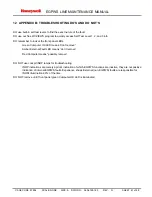
EGPWS LINE MAINTENANCE MANUAL
CAGE CODE: 97896
SCALE: NONE SIZE: A
DWG NO.: 060-4199-180
REV: G
SHEET 51 of 68
4 MAINTENANCE
PRACTICES
4.1 GENERAL
Normal maintenance activities performed on the EGPWS should follow standard industry maintenance practices.
System maintenance practices may include; updating a database, downloading flight history data, and programming
or reprogramming the MK VI, MK VIII or MK XXII Configuration Module. These are addressed in the following
sections.
4.2 DATABASE
UPDATE
The Enhanced Ground Proximity Warning System (EGPWS) uses Terrain, Obstacle, Runway, and Envelope
Modulation databases to provide enhanced functions. These are periodically updated, as new data becomes
available. The Terrain, Obstacle, and Runway databases are typically combined and loaded into the EGPWS as
one database, however it is possible that individual database updates could be provided. The procedure for loading
a database update is the same in all cases and this section will address them as a database update generically.
For each new (updated) database, Honeywell will provide notification of the new database via a Service Information
Letter (SIL). The SIL will be sent to all registered EGPWS customers, or they will be available for Internet download
from Honeywell Technical Publication website or the EGPWS website at www.egpws.com. The SIL will contain a
description of the changes in the database, as compared to the previous database, so that each customer can
determine the applicability of the database update to their operations. For example, a Terrain database update
involving only terrain in South America will be of no value to a domestic U.S. airline. Thus, the domestic U.S. airline
would not need the database update. The SIL will also contain instructions on how to obtain the new Terrain
Database and any required modifications. Database updates are coordinated with the FAA prior to SIL release via
a Honeywell “minor mod” notification process. Installation and verification of terrain databases is addressed in a
generic Service Bulletin.
EGPWS databases are not identified on the EGPWC nameplate as a part of the unit part number. However, for the
MK V and MK VII, there is a label on the inside of the front panel maintenance door that can be used for identifying
the installed terrain database. For the MK VI, MK VIII, and MK XXII a separate label is placed on the unit front
panel identifying the installed Terrain database version number and for the MK VI and MK XXII the database region
(see section 2.2.10.1). Otherwise, the installed databases can be determined in the Level 3 Self-Test (see Section
3.5) which should always be used to confirm the current database version.
4.2.1 DATABASE UPDATE FREQUENCY
Honeywell is continually striving to improve the EGPWS databases. New terrain, obstacle, or runway data is
obtained by many different means, evaluated and verified, before it is processed into an EGPWS database. When
sufficient or significant new data is available, Honeywell will release a database update.
Honeywell is committed to investigating reported nuisance alerts. When nuisance alerts result from database
problems (accuracy or resolution) Honeywell will make corrections to the database. Nuisance alerts can also result
in changes to the Envelope Modulation database, although this tends to be less frequently updated.
It is up to the EGPWS customer to determine if a specific database update is applicable to their operation.
Honeywell recommends always operating with the latest database.
NOTE
: Some database updates may require a hardware or software mod. Any required modification information
will be identified in the associated database SIL.
Operators can visit the EGPWS website Database page and enroll in a distribution list that sends e-mail notification
when a new database is released. Also on this website page is a Future Content and Schedule document the gives
details on the expected release dates for 3-4 future databases.
4.2.2 LOADING A DATABASE
A database is loaded into the EGPWC via the PCMCIA card slot in the front panel in the MK V and MK VII. In the
MK VI, MK VIII, and MK XXII a “Smart Cable” data-loader is connected to the Test connector on the front panel.






































